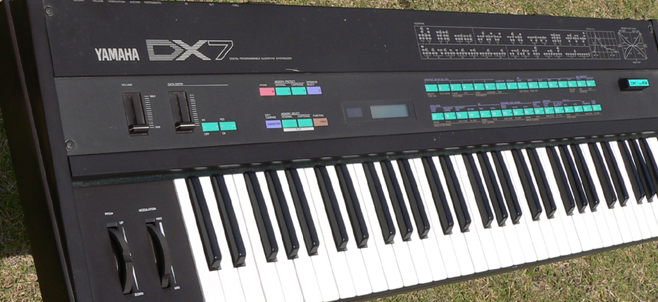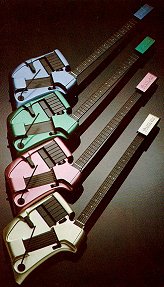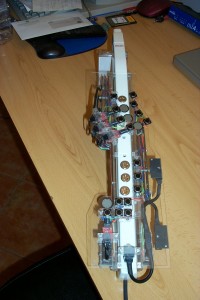I am humbled to report that I am the subject of a major feature this morning in one of the national papers….
From today’s Guardian-
Modern Maestro Rescues the Classics
Conductor Kenneth Woods found his own path to the podium.
While many of his podium colleagues and rivals spent their teens and twenties practicing score reading and transposition, Woods spent this formative years in the 1980’s as a rock and pop guitarist, immersed in the vernacular music of his time.
”When I first put down the guitar and took up the baton,” says Woods, “people saw me as a disruptive outsider who didn’t understand the traditions of classical music. But a great man once said that tradition is the last bad performance. I knew, from what I’d learned playing the commercial music of the 1980’s, that the “tradition” as it existed and still exists, had to be destroyed in order for us to restore the great classical masterpieces to the kind of performances envisaged by their composers.”
While other conductors were learning their craft from teachers and mentors corrupted by lazy mainstream practices, Woods had been reading the letters and writings of Beethoven, Wagner and Mahler, trying to better understand their goals and aspirations.
“It’s commonly taught in conservatories that the great classical innovators were all looking for something fresh- seeking The New, it was called” says Woods, “but this is something of a misunderstanding. Wagner was not so much seeking the New as he was seeking The New Wave. The great composers were not these stuffy, establishment figures they’ve been portrayed as- they wore wigs and frilly shirts, just like the masters of the 1980’s New Wave. Once I made the connection, I understood that the great composers had been writing music for an 1980’s pop aesthetic in expectation of the technical revolutions to come.”
Of course, it took many years for Woods to find himself in a position to tackle the big orchestral warhorses. “We had to start small- the first experiment was my recording of the Brahms cello sonatas in the early 1990’s.”
“Brahms had often written about the importance of a range of color in his keyboard music. The modern piano is too monolithic and too heavy for his music, and it’s very size and volume also force the cellist to play too loud much of the time. On a modern Steinway, Brahms keyboard writing comes off as over-thick and leaden, where it should be clean and transparent.”
“Fortunately, in this age we had at our disposal the miraculous tool of Yamaha’s FM Synthesis. The DX7 was the tool Brahms always wanted and never had- those clean digital waveforms from the Rhodes patch used on so many 80’s ballads combined lean-ness with unlimited digital sustain.”
(Modern Musical Miracle Machine- the Yamaha DX7)
Of course, once he saw the potential of the new technology in revealing Brahms’ true intentions, Woods couldn’t stop with the keyboard. “the cello is too old-fashioned for Brahms concept of New Wave music. The intonation doesn’t match with the keyboard, and you can’t add any digital delay or chorus effect to an acoustic cello. I tried an electric cello, but the bow changes get in the way of the music. Eventually, I realized I could use a Synthaxe. That allowed me to combine wave forms from several synthesizers, just as Brahms would have wanted, while using a sustain pedal to achieve infinite phrase lengths without the unmusical interruptions of breathing or bow changes. Then, running the output through twinned Peavey amplifiers, I could sweeten the sound with a bit of chorus and increase the snap on the front end with a little digital delay. We also performed with a lot of hairspray and make up, wearing historically appropriate shoulder pads.”
Over the years, he found kindred spirits, eventually convincing his string quartet to set aside their antiquated Italian violins and violas in favor of “Originally Intended Instruments,” a matching set of Synthaxes in pastel colors.
(The Synthaxes used by Woods’ quartet for their recordings of Beethovens op 127, 130, 131, 132 and 135 String Quartets. Woods used the teal one for the big cello solo in the “Heiliger Dankgesang eines Genesenen an die Gottheit in der Lydischen Tonart)
Once on the podium, Woods quickly began to reveal the New Wave aspirations of Beethoven. “Beethoven was the original New Wave composer- just look at his hair and his penchant for innovation. He always had to have the latest pianos, including the magnificent Broadwood he bought after he’d gone deaf. He was never satisfied with the clumsy mechanical sound production systems of the instruments of his day, and his piano sonatas sound much more as he intended them to on a modern synthesizer.”
In working with orchestras, Woods began with the instruments that most affect the sound of the overall ensemble- the kettledrums. “Modern timpani are too flabby, too soft edged. It’s not what Beethoven had in mind at all- he wanted articulation, clarity and a more reliable tuning system. Early on, we replaced mechanical timpani with Originally Intended Instruments- Roland drum triggers. My time in the studio in the 80’s had given me a chance to really understand the makings of the Phil Collins drum sound, which was so popular for good reason. By combining triggered timpani samples with a mixture of digital delay, digital reverb and a subtle chorus effect, then pulling out all the mid-range in the EQ stage, we could unleash the perfect authentic timpani sound, with 100% accurate pitch control, and we could even use the synthesizer to control the exact amount of decay as well as how much stick noise you want. With the trigger pads, you no longer have to switch sticks to get a different sound, you can just change patches. You can even adjust dynamics with a foot pedal so you don’t have to worry about how hard you hit them”
From there, it was on to the trumpets, where Woods felt modern era instruments were also doing a tremendous amount of damage. “The modern trumpet is a legato instrument, with a rounded sound and a rather smooth articulation- Beethoven wanted the trumpet to reinforce the rhythmic contour of the music. If you try to play a modern trumpet with enough edge and bite to satisfy the needs of the score, it is too loud for the strings.”
The solution was obvious “80’s pop music had demonstrated with amazing effect that could replace a clumsy and expensive horn section, who soak up much too much of your gig fees anyway and crowd the bus, with a keyboard. The DX7 had lots of good trumpet patches, and when you play Beethoven’s trumpet parts on a modern, digital, touch sensitive keyboard, you have no possibility of missed notes or tuning problems, and the articulations always match perfectly. For the first time, we were able to use modern technology to show listeners what Beethoven really originally intended.”
Woods’ Beethoven quickly gained notoriety bordering on infamy. “Complete bullshit,” was how one obviously jealous conductor described his approach while critics called it “provocative” and “possibly right?”. Woods performances of the Beethoven symphonies were also enhanced by the use of makeup, hairspray and colored lighting, as well as shoulder pads and leggings for the performers.
“Wagner coined the term Gesamkunstwerke, meaning “total-artwork,” a synthesis of musical, literary and visual arts, manifest in his mature operas, but Beethoven was his hero, his model. In his time, options for concert lighting were limited, but he would have loved having a light show that could enhance the experience of the music. I’m proud to have elevated Beethoven’s mere abstract instrumental symphonies into true Gesamkunstwerken.”
Since then, he has stormed through the repertoire, bringing an 80’s sensibility to his performances of Rite of Spring with an all-drum-machine percussion section, the Dvorak Wind Serenade with a matched set of Yamaha Midi wind controllers, and on and on.
(Midi Wind Controller used for Dvorak, allowing balances to be corrected at the main mixing board by the sound guy)
In Mahler, he wasn’t content merely to use five-string electric violins as Mahler obviously intended, but he also addressed the corrupting influence the modern operatic singing technique was having on classical vocal music.
“Opera singing is basically controlled screaming,” explains the now veteran conductor as we enjoy a fine Bordeaux in the east wing sitting room of his sprawling Cotswold farmhouse. “200 years of trying to belt out above an orchestra has taken the freshness out of singing. Thank goodness we have microphones now! With microphones, we can use any singer we want to without worry about whether or not they’ll be heard over the orchestra. We can choose a singer based on their artistry and image, not their voice. We can also use a single quick-snap effect on the digital delay to enhance diction.”
In the recording studio, Woods was able to use technology to get even closer to perfection. “When I recorded Das Lied von der Erde with Annie Lennox and Bob Geldof, we were able to multi-track the whole thing, which allowed us to control the exact dynamic of every note in the vocal parts during mix down. Then we could go through and pitch-correct everything in Pro-Tools, and really get it to sound just like Mahler intended.”
The connection with Geldof proved essential in planning the grandest of his projects. “I knew we had to “get involved”- you know, classical musicians are basically a bunch of lazy assholes who care only about their antique car collections and their Cuban cigar habits.They were so far behind pop stars in doing things to make a difference for children in Africa. An historically accurate 80’s approach was the only way to get us on track. I called Geldof and asked if he could help me get together something “classical” for Africa, and the next thing you know, we were recording the Brahms German Requiem with an all pop-star chorus and Quincy Jones producing.’
Woods says he still remembers the first rehearsal. “When I gave the downbeat and Sting, Bono, Take That and Lionel Richie all started singing “Selig Sind,” I knew we had something special, and when Morrisey cut loose on “Denn wir haben hie keinen bleibende Statt,” I knew we were documenting Brahms’ music as he always wanted it to be heard.”
The “German Rock-We-Them” project went on to sell 20 million copies, raising nearly $10,000 for charity and, although critical opinion at the time was mixed, most leading critics have come around. “Bold?” is how Alex Ross from the New Yorker describes the project today, while “unique” and “um, radical” are how Anthony Tomasini at the NY Times remembers it. Guardian blogger Tom Service called it “something else….” while senior Guardian music critic Andrew Clements called Wood’s approach “quintessentially American.”
His recording of the Brahms Piano Concertos with Chick Correa playing a Kurzweil was hailed by Keyboard Player magazine as “totally unprecedented.” Recent years have taken Woods into the opera house, for memorable productions of Rosenkavalier with Tears for Fears and this year, a highly praised version of Tristan with Robert Smith from the Cure in the title role.
“Now, with fog machines that don’t interfere with wind-players clumsy need to breathe, we can really create more of a stadium vibe in the concert hall. The sky is the limit. Even mainstream orchestras are opening up to shoulder pads, make up and digital delay.”
Woods shows no sign of slowing down in spite of his age- “I’m just so unselfishly passionate about getting this music heard as the composers intended, without all the flaws of acoustic instruments that I can never stop, never slow down,” says Woods.



You may blow your own trumpet, Kenneth.
“Woods says he still remembers the first rehearsal. “When I gave the downbeat and Sting, Bono, Take That and Lionel Richie all started singing “Selig Sind,†I knew we had something special, and when Morrisey cut loose on “Denn wir haben hie keinen bleibende Statt,†I knew we were documenting Brahms’ music as he always wanted it to be heard.—
I quite literally LOLed.
I always thought the guy from Human League would have done a fantastic job singing Bluebeard’s Castle…I hope that lies in the cards down the line.
You are too modest.
I read the post twice and yet you failed to mention your milestone recordings of the complete Debussy Song Cycles featuring Robert Plant.
Maybe next year…
Well- since, not any great surprise, I’ve had 3 emails about this post from people who obviously hadn’t twigged that it was published on April 1st, let me just point that out.
KW
I must admit you had me until the Brahms/Yamaha DX7 bit. Reminds me of a story about classical musicians getting their instruments pierced as reported by Luther Cremona.
ROFL!! You had me right up until I finished the DX7 stuff!
So when do I get an autographed copy of this Brahms Sonata? ;)
Pure gold!